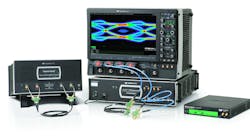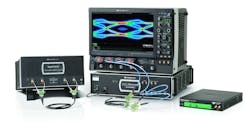Oscilloscopes are measurement workhorses in any RF/microwave designer’s test arsenal, so the news that two series of high-performance oscilloscopes from Teledyne LeCroy have been given significant improvements is most welcome. The enhancements come to the company’s LabMaster 10 Zi and WaveMaster 8 Zi oscilloscope models, now with analysis capabilities through 100 GHz.
The new WaveMaster 8 Zi-B instruments feature improvements extending to bandwidths of 30 GHz and sampling rates to 80 GSamples/s. These instruments include advanced waveform processing by merit of their built-in personal computers, based on 3.1-GHz quad-core microprocessors, along with as much as 32 GB of random-access memory (RAM). With a 14.1-Gb/s serial trigger, these oscilloscopes are well suited for serial data analysis.
The WaveMaster 8 Zi-B oscilloscopes (see figure) include 50-Ω and 1-MΩ input ports for flexibility when connecting probes and test ports. Results are shown on a 15.3-in. high-resolution touchscreen display screen. The instruments include as much as 512 Mpoints of waveform analysis memory for two-channel configurations at 80 GSamples/s. For instruments with four channels, as much as 20 GHz bandwidth per channel is available, with 40 GSamples/s sampling rate and 256 Mpoints of analysis memory.
For those needing even higher frequencies, the LabMaster 10 Zi oscilloscopes now reach 100 GHz. Models in the line have been improved with enhancements in effective number of bits and baseline noise and in reduction of jitter. The LabMaster 10 Zi instruments operate at maximum sample rates to 240 GSamples/s and have cut sample clock jitter to a mere 50 fs.
The modular ChannelSync architecture of these instruments simplifies the construction of multiple-channel measurement systems. It allows operators to run as many as 80 oscilloscope channels in synchronization with better than 130-fs channel-to-channel timing uncertainty (jitter).
In support of the new instruments, the company has also unveiled its PAM4 signal analysis software. Teamed with one of the oscilloscopes, the software makes it possible to perform eye, jitter, and noise measurements on all three eye openings of a PAM4 signal, which is required for those working on systems relying on PAM4 signaling technology. A PAM4 system encodes 2 b of information per symbol rather than 1 b by using a four-level signal.
This doubling comes at a price of increased signal complexity compared to two-level non-return-to-zero (NRZ) signaling. The PAM4 eye diagram contains three eye openings rather than one, and includes 12 types of transitions rather than two. Paired with any of these oscilloscopes, the software helps to evaluate the characteristics of these complex signals.
Teledyne LeCroy, 700 Chestnut Ridge Rd., Chestnut Ridge, NY 10977-6499; (800) 553-2769, (845) 425-2000, FAX: (845) 579-5995

